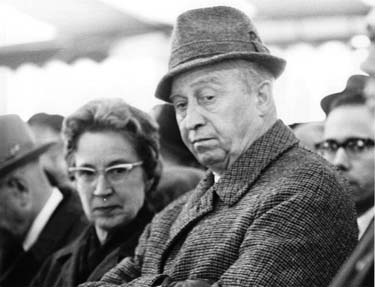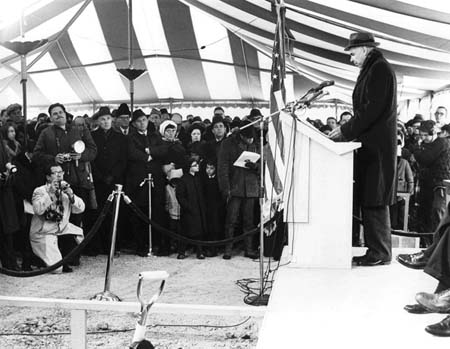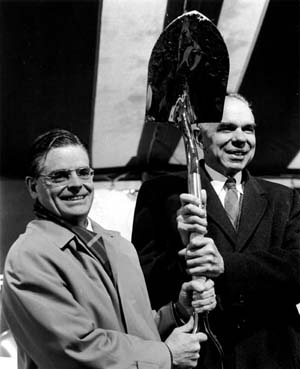Remarks by Dr. Glenn T. Seaborg, Chairman U.S. Atomic Energy Commission
This is a very exciting and meaningful day for all of us gathered here. With this ground-breaking ceremony we move one step closer to the realization of a great new scientific enterprise - a national laboratory that will help man to advance significantly into new frontiers of knowledge. Symbolically, we could say that the spade that breaks ground on this site today begins our deepest penetration yet into the mysteries of the physical forces that comprise our universe.
Since this is an historic event perhaps it is appropriate that we recall some of the historical developments that have culminated in this ground-breaking ceremony here today. When we reflect upon the relatively short history of high energy physics, there can be no doubt that the development of this important area of fundamental scientific research has been astounding in terms of productivity and growth. Only a little more than twenty years ago plans were initiated for constructing accelerators in the billion volt range. These early plans materialized in the Cosmotron at Brookhaven and the Bevatron at Berkeley; both truly prodigious in their contributions to the field. As time went on other excellent machines and facilities were designed and built, and their exploitation has assured the solid growth and progress of high energy physics. This strong dependence upon large, complex, and costly machines inevitably brought wide national attention to the field.
Throughout the history of the 200 BeV Accelerator project the interest and encouragement given by the Joint Committee on Atomic Energy has been crucial. The Committee's concern for scientific progress, along with essential program economies, provided a firm foundation from which to move ahead with the project. In its report for Fisca1 Year 1965, the Committee strongly urged that the Atomic Energy Commission take the lead in developing a national policy for the high energy physics programs. The Commission responded by developing the document entitled "Policy for National Action in the Field of High Energy Physics," transmitted to the President and then by him to the Joint Committee on Atomic Energy in January 1965. The policy for this field of research had been evolving over a period of years, marked by a series of studies and reports beginning in 1954.
All of these studies contributed to the formulation of the document prepared by the AEC; indeed the text of each of these reports is embodied in that policy document. After the Joint Committee received the policy statement from the President its Subcommittee on Research, Development and Radiation under the chairmanship of Mel Price held a weeklong series of hearings in March of 1965 on the status and achievements of high energy physics, including discussions of the 200 BeV Accelerator and the policy document.
Let me read to you a portion of the document:
"Proton energy is the single most important parameter to be extended. . ."
"There are now clear needs for a proton machine following the conventional alternating gradient synchrotron (AGS) design but having an energy of hundreds of BeV. These needs can best be met by the immediate design and construction of an AGS in the 200 BeV range. . ."
The Lawrence Radiation Laboratory of the University of California spent two intensive design years on an accelerator in this range, and in April of 1965 the Commission began one of its longest, most interesting, and certainly most difficult tasks - the selection of the most appropriate site in the United States for a 200 BeV proton accelerator. Site criteria for such a national laboratory for basic research were issued, based on the studies done by the Lawrence Radiation Laboratory. The avalanche of site proposals began, and for the next twenty months the Commission, its staff and a select committee, appointed by the National Academy of Sciences and headed by Dr. Emmanuel Piore, wrestled with the detailed evaluation of 126 proposals that included well over 200 sites in forty-six states.
On-site visits by inspection teams were made to the nearly 150 sites that met the basic criteria, and by March 1966 the National Academy of Sciences Site, Selection Committee recommended to the Commission six areas - actually seven different sites. Two sites were in the Chicago area.
On December 16, 1966, the Commission, after many meetings and intensive review of all the material on the recommended sites unanimously selected this site for the 200 BeV Accelerator. It was a busy day - and there have been some busy days since then.
Meanwhile, another very important aspect of the new project was under consideration; namely the management of the project. From the beginning it was understood that the 200 BeV Accelerator would be a national facility available to all, on the basis of scientific merit. It was also clear from the outset that the management of the facility must have national orientation and representation.
It was not at all clear, however, how this was to be accomplished. Many discussions were held on this matter. Early in 1965 Dr. Frederick Seitz, after consultations with the Office of Science and Technology, the AEC, and the National Science Foundation, called together representatives from universities most directly concerned with high energy physics in order to consider appropriate managerial patterns for future high energy nuclear accelerators. At this meeting, held at the National Academy of Sciences on January 17, 1965, it was agreed that the universities should form an association, nationwide in membership, for the purpose of offering its services as manager of future large Federal research facilities. The resulting organization, now known as Universities Research Association (or URA), was organized initially with 34 members under its first president, Dr. J. C. Warner. He has been succeeded by the current President, Prof. Norman F. Ramsey, and the organization has grown to 48 members including one in Canada.
I would like to turn for a few moments to another most important aspect of this project. Early in 1967, soon after the Commission had announced that the National Accelerator Laboratory was to be built here, many questions were asked concerning the civil rights aspects of the selection. The Commission was severely criticized by some for having selected a site in an area which did not appear to have accepted the concept of equal opportunity for all, regardless of race, creed, color, or national origin. In answer to this criticism, I told the Joint Committee on February 8, 1967, that "a satisfactory solution to the human rights problem is more important than this accelerator. However, they are not in conflict here at the Weston site. We believe that construction of the accelerator at Weston and advancement of human rights can complement one another." In short, we regarded the civil rights challenge as an opportunity to be met, and I believe that we are meeting that opportunity in the right way.
The National Accelerator Laboratory has been a catalyst for change. No less than fourteen communities within the commuting radius of this site have adopted open occupancy laws since the selection was announced.
Indeed, NAL has been far more than a catalyst. It has actively and effectively promoted policies of equal opportunity, looking both to the present and the future, in cooperation with AEC's Chicago Operations Office and DUSAF, the architect-engineer. It has cooperated with local unions in promoting pre-apprenticeship and other training programs for the construction industry, and in recruiting minorities to participate in these opportunities. Thus far, 71 young minority men have been given a chance, previously unavailable to them, to work in the construction industry in this area. In promoting these programs, NAL and its associates have found cooperation and even encouragement from local building trades unions, from local industry, and from local community leaders.
The Laboratory will continue to provide such opportunities, both in its construction and its operation, for disadvantaged men and women in this area. The dedication to equal opportunity shown by the Laboratory and its associates will, I believe, demonstrate that with enlightened federal, state, and industry cooperation, scientific progress and human progress can go hand in hand.
The Atomic Energy Commission at the beginning of 1967 entered into its first contract with the Universities Research Association for a design study, and the National Accelerator Laboratory came into being. The first step was to find a Director; the choice happily fell on Professor Robert R. Wilson who was then completing work on a large electron accelerator at Cornell. He rapidly assembled a design group at Oak Brook, in the western suburbs of Chicago. In 1967, a summer design effort took place, involving many of the nation's accelerator specialists. An NAL Users Group, reaching into almost every institution in the country where theoretical or experimental high energy physics is studied, was organized the same year to assist the laboratory in planning.
Meanwhile the staff of the NAL was taking form, and in the current year their varied efforts and substantial achievements have provided a very impressive beginning. The signing of a definitive design and construction contract last January, and the appropriation only a few months ago of funds to begin construction of the laboratory's first buildings, assure that progress is to continue.
During all this time, from the beginning and through all these important stages of planning and initial work, we have had the firm support of President Johnson for this project. And we are grateful for that support.
Now we have come to the point of breaking ground for the first of the buildings to house the accelerator. Appropriately enough, the first structure to be built is the housing for the linear accelerator. Eventually in this housing, the protons will begin their trip through the accelerator.
This linear accelerator housing is the beginning of the major construction program aimed at completing the accelerator itself by mid-1972 and the laboratory as a whole by the end of 1973. After the construction of this housing is started, the booster-accelerator housing will be initiated, followed by the mile-and-a-quarter diameter main ring tunnel. At the same time, construction of the accelerator components - magnets, vacuum chambers, power supplies and so forth - will have been started, and, as the accelerator housings are completed, the accelerator systems will begin to take shape within them.
The linear accelerator will be completed first. Then, when the booster accelerator is finished, its shakedown will be carried out using protons injected from the linear accelerator. Likewise, when the main ring accelerator is ready to receive protons, they will be available from the booster. Thus each component of the 200 BeV Accelerator complex will be tested on a timely schedule.
This construction schedule is an intensive and demanding one. The payoff will come, if all goes well, in the middle of 1972 when Professor Wilson and his staff expect to achieve the first 200 Bev research program.
Particle accelerators have long been indispensable to nuclear research as the sources of energetic particles with which to probe the nucleus and its constituents. The Atomic Energy Commission has sponsored a series of high-energy accelerators for the investigation of the fundamental particles and laws of physics. These accelerators, the Cosmotron and Alternating Gradient Synchrotron at Brookhaven National Laboratory, the Bevatron at Berkeley, the Zero Gradient Synchrotron at Argonne National Laboratory, the Stanford Linear Accelerator, the Cambridge Electron Accelerator, and the Princeton-Pennsylvania Accelerator, have produced a wealth of new knowledge: the verification of the existence of anti-particles of nucleons, the discovery of a host of new particles, the discovery of unexpected asymmetries in nature, and many other things. Each time a new regime of energy has been entered, a wealth of new phenomena has been revealed, and we have come closer to an understanding of the forces at work in the nucleus.
With the 200 BeV Accelerator at the National Accelerator Laboratory, we take another step in energy, eagerly anticipating the revelations the new energy regime may have in store for us.
We are proud of the accomplishments of the URA, the National Accelerator Laboratory and of all the distinguished scientists and engineers who have contributed to this project. They have produced an efficient and economical accelerator design which has favorably impressed scientists all over the world. They have planned and initiated an expeditious construction schedule. This afternoon, this groundbreaking ceremony symbolizes the start of the major construction of the National Accelerator Laboratory. We congratulate Professor Wilson and his staff, and we look forward to a highly successful program.








